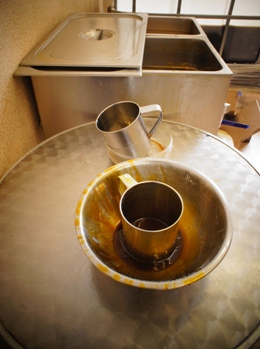 Begumpet ,Hyderabad
Begumpet ,Hyderabad
500 016, A.P, India.
Phone No : +91-40-2340 2682
Mobile : +91-9959000380
E-mail : info@conewafer.com
Note: Click on any link or the contact Image auto closes the panel.
Raw Material
Emulsfiers

Emulsifiers are natural or synthetic substances that promote the formation and improve the stability of emulsions, e.g., dispersion of fat droplets in aqueous solutions or of water droplets in a continuous lipid phase. In some cases, they can be used to improve wetting properties-change the surface tension-of water or aqueous solutions. Surface active agents are widely employed in the baking industry for these purposes.
The unifying characteristic of emulsifier molecules is the presence of a hydrophilic group (attracted to water) and a lipophilic group (attracted to fatty substances). Not all such molecules have practical value as surface active agents, however. It is not necessary that the hydrophilic and lipophilic groups have equal effectiveness; as a matter of fact, it is usual to find that one or the other plays a dominant role in the action of the emulsifier. The variability in performance of different emulsifiers is the result .of the relative potency of the two kinds of regions, their spatial relationship, the size of the entire molecule, and certain other factors. There are some very potent emulsifiers that cannot be used in foodstuffs because of legal restrictions. There are a few that are acceptable in most standardized foods, however, and several more are permitted in non standardized foods.
Without a screening system, the time required for selecting an emulsifier of optimum function for a given application might prove to be prohibitive. A pre screening system or emulsifier rating scale that has been rather widely used is the HLB (hydrophile-lipophile balance) scheme (Anon. 1963). In brief, this method provides rules for assigning an HLB number to the combination of ingredients that are to be emulsified, and then directs the selection of an emulsifier or blend of emulsifiers having the same number. The HLB numbers of all common emulsifiers can be found in the literature. Unfortunately, it is not as easy to secure the HLB numbers of ingredients.
Some (but not all) emulsifiers form complexes with starch, and particularly with amylose. Apparently, the HLB numbers are of little or no value in predicting the starch-complexing ability of surfactants: It appears that starch must be gelatinized before the full effect of this complexing action is observed. The exact nature of the reaction is a subject of continuing debate, but the most recent opinions seem to favor the view that a kind of clathrate is formed, with the long amylose molecule wrapped around an extended molecule of, for example, monoglyceride.
The starch-complexing ability of emulsifier-like substances appears to be related to an initial crumb-softening effect and/or a slowing of the starch retrogradation that is widely believed to be the cause of texture staling and firming of baked products such as bread. In addition to their fat-dispersing and starch complexing properties, some emulsifiers also-appear to strengthen the gluten and assist aeration. Other functions have been claimed for some of them.
The unifying characteristic of emulsifier molecules is the presence of a hydrophilic group (attracted to water) and a lipophilic group (attracted to fatty substances). Not all such molecules have practical value as surface active agents, however. It is not necessary that the hydrophilic and lipophilic groups have equal effectiveness; as a matter of fact, it is usual to find that one or the other plays a dominant role in the action of the emulsifier. The variability in performance of different emulsifiers is the result .of the relative potency of the two kinds of regions, their spatial relationship, the size of the entire molecule, and certain other factors. There are some very potent emulsifiers that cannot be used in foodstuffs because of legal restrictions. There are a few that are acceptable in most standardized foods, however, and several more are permitted in non standardized foods.
Without a screening system, the time required for selecting an emulsifier of optimum function for a given application might prove to be prohibitive. A pre screening system or emulsifier rating scale that has been rather widely used is the HLB (hydrophile-lipophile balance) scheme (Anon. 1963). In brief, this method provides rules for assigning an HLB number to the combination of ingredients that are to be emulsified, and then directs the selection of an emulsifier or blend of emulsifiers having the same number. The HLB numbers of all common emulsifiers can be found in the literature. Unfortunately, it is not as easy to secure the HLB numbers of ingredients.
Some (but not all) emulsifiers form complexes with starch, and particularly with amylose. Apparently, the HLB numbers are of little or no value in predicting the starch-complexing ability of surfactants: It appears that starch must be gelatinized before the full effect of this complexing action is observed. The exact nature of the reaction is a subject of continuing debate, but the most recent opinions seem to favor the view that a kind of clathrate is formed, with the long amylose molecule wrapped around an extended molecule of, for example, monoglyceride.
The starch-complexing ability of emulsifier-like substances appears to be related to an initial crumb-softening effect and/or a slowing of the starch retrogradation that is widely believed to be the cause of texture staling and firming of baked products such as bread. In addition to their fat-dispersing and starch complexing properties, some emulsifiers also-appear to strengthen the gluten and assist aeration. Other functions have been claimed for some of them.
Copyright © conewafer.com, 2020.